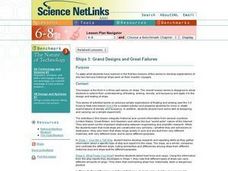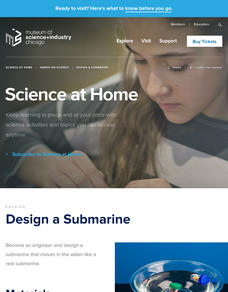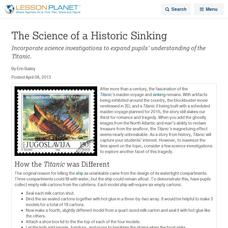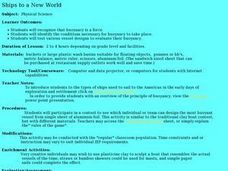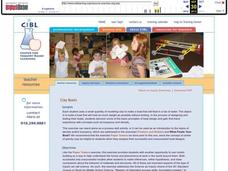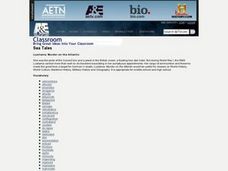Curated OER
Ships 3: Grand Designs And Great Failures
Middle schoolers engage in this, the third in a three-part series on ships. The overall instructional activity series is designed to allow students to extend their understanding of floating, sinking, density, and buoyancy and apply it to...
Curated OER
Design and Function of Native Watercraft
Students design clay boats and test their floating ability. They sketch and record each test different boat designs. They compare their designs to those of native Inuit vessels by looking at images and attempting to determine the...
Curated OER
What Floats Your Boat?
Students discover the Archimedes principle through a buoyancy experiment. They measure the water displacement of a lump a clay which is denser than water then reshape the clay into a bowl which floats but displaces more water.
American Physiological Society
How Does the Density of a Liquid Affect the Buoyancy of an Object?
Here's a lesson plan that will really float your boat! Introduce physical science scholars to the relationship between buoyancy and density through an assortment of individual and collaborative exercises. Lab groups work together to...
Museum of Science
Design a Submarine
Don't just sink the boat. Using a closed container as a submarine, pupils experiment to see what to add to the container to make it float, sink to the bottom, and hover in the middle. After finding one option, learners see if they can...
Curated OER
The Science of a Historic Sinking
Incorporate science investigations to expand pupils' understanding of the Titanic.
Curated OER
Gift for the Indians: Model of the Mayflower in the Ocean
Students build a miniature replica of the Mayflower. They make the boat float in a cup of water while studying the concept of gift giving on Feast Day.
Curated OER
Float the Boat
Students collect data and analyze it using a graph. In this algebra activity, students identify different bodies of water and relate the flowing to math. They collect data on the rate of flow and the height of flow. They analyze the data...
Curated OER
Float Your Boat
Students investigate buoyancy, displacement and density. In this flotation lesson students study the Archimedes' Principle, analyze data and draw conclusions.
DiscoverE
Design a Flotation Device
Save the soup! Scholars devise a flotation device using straws, balloons, foam, corks, and other objects. A can of soup must stay afloat for at least a minute with this device—your dinner might depend on it!
Curated OER
Floaters and Sinkers
Fifth graders define density as the amount of mass per volume a material contains, compare the densities of several types of materials, especially those that sink in water compared to those that float. They use two different methods to...
Curated OER
I've Got That Sinking Feeling
Students design a simple boat and predict how much weight it can carry. They should also discover why objects float or sink and how this can be determined experimentally. A great lesson on buoyancy!
Curated OER
Why Cheerios Don't Sink
Students investigate Archimedes' Principle and show how it relates to density. For this Archimedes' Principle lesson plan, students experiment with a beaker of water, a Styrofoam "boat" and a weight. They predict what will happen when...
Curated OER
Build Your Own Submarine
Students construct their own submarine following a certain procedure. In this physics lesson, students calculate the density of objects using a mathematical formula. They explain why some object floats in water while some do not.
Curated OER
Ships to a New World
Students experiment with buoyancy as a force. In this buoyancy lesson, students access an assigned website to examine the sailing vessels that came to the New World. They work as teams to build boats out of aluminum foil to see which...
Curated OER
Clay Boats
Seventh graders are given the opportunity to use model-building as a way to help comprehend the forces and phenomena at work in the world around them. They use both successful and unsuccessful models to make inferences, refine...
Curated OER
Float Your Boat
Students design an experiment to find density using Archimedes' Principle. In this physics lesson, students calculate density using mass and volume. They share their findings in class.
Curated OER
Concrete Canoes
Young scholars explore and analyze the relationship of buoyancy and displacement needed to make an object float. They examine various boat designs, then design and build clay and aluminum boats that hold a cargo of marbles.
Curated OER
An Uphill Swim
Students explore the concepts and engineering principles used in a canal lock system and apply those concepts to navigate a boat through a working model of a canal lock waterway.
Curated OER
Lusitania: Murder on the Atlantic
Students explore the pride of the Cunard line and a jewel in the British crown; a floating four star hotel. But during World War I, the RMS Lusitania carried more than well-to-do travelers luxuriating in her sumptuous appointments.
Curated OER
Science: Exploration Tubs
First graders develop skills of scientific inquiry. They determine which objects float and which sink.
Curated OER
The Crew Problem
In this algebra worksheet, learners rewrite word problems using algebra. They calculate how fast the river is flowing as team members row their boats upstream. There is an answer key to this problem.
Curated OER
Aircraft
A variety of concepts are covered in this PowerPoint which gives the main engineering points of different aircraft types. Each slide details the engineering behind non-rigid and rigid categories of lighter or non-lighter than air...
K12 Reader
Change Adjectives into Adverbs
What do you need to turn an adjective into an adverb? Sometimes you need an -ly, but there are other endings. Ask your learners to change the endings of 29 adjectives in order to transform them into adverbs and complete the provided...


